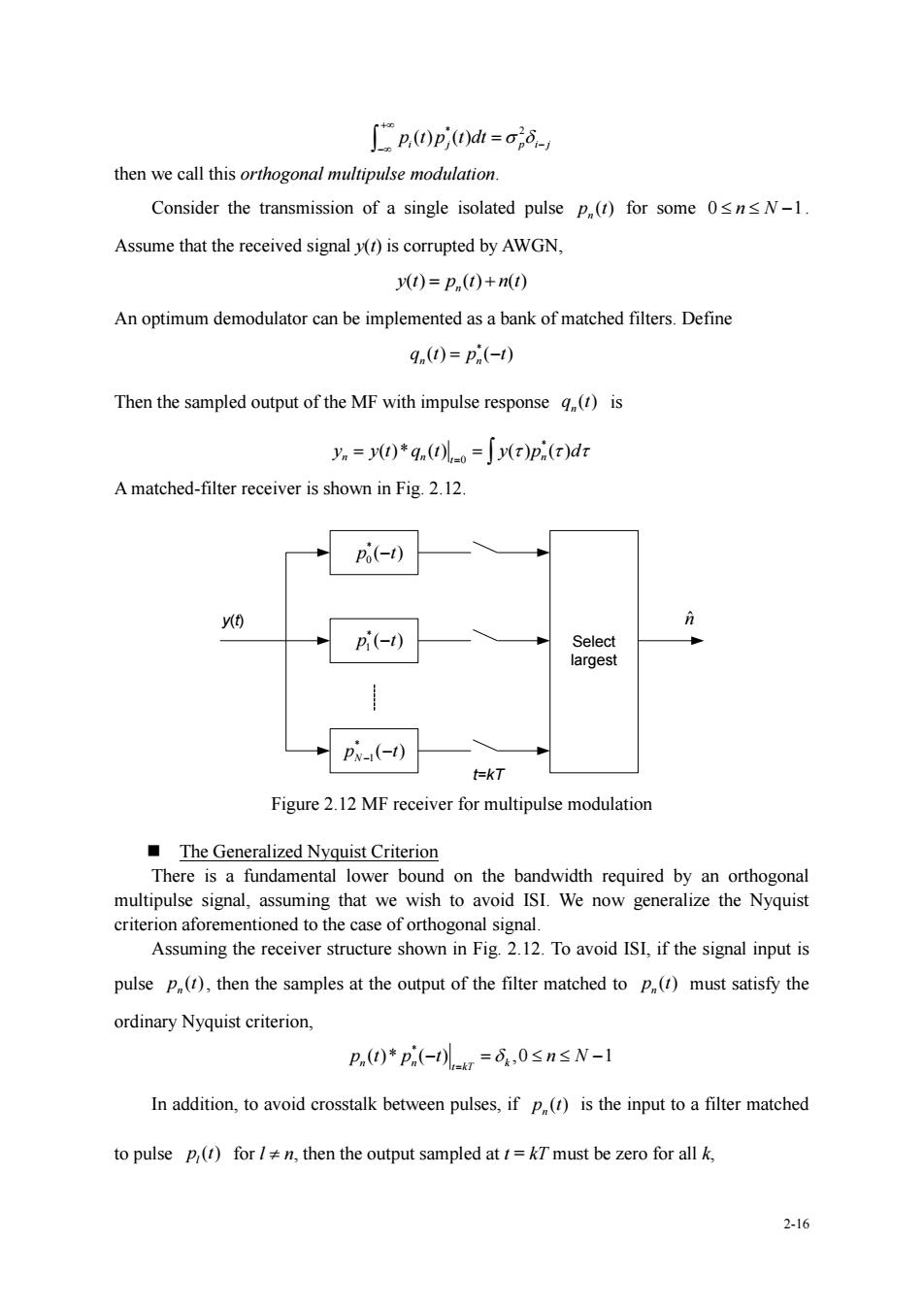正在加载图片...

[p.(t)p;(t)dt=a6_ then we call this orthogonal multipulse modulation. Consider the transmission of a single isolated pulse p(r)for some 0snsN-1 Assume that the received signal y()is corrupted by AWGN, 0)=P()+) An optimum demodulator can be implemented as a bank of matched filters.Define g.(t)=p(-t) Then the sampled output of the MF with impulse response()is y.=y(1)q.(t)=y(r)pi(r)dr A matched-filter receiver is shown in Fig.2.12. p(-) 畅 gd +pw(-0 Figure 2.12 MF receiver for multipulse modulation The Generalized Nyquist Criterion There is a fundamental lower bound on the bandwidth required by an orthogonal multipulse signal,assuming that we wish to avoid ISI.We now generalize the Nyquist criterion aforementioned to the case of orthogonal signal. Assuming the receiver structure shown in Fig.2.12.To avoid ISI,if the signal input is pulse p(),then the samples at the output of the filter matched to p()must satisfy the ordinary Nyquist criterion, p.()*pi-=6,0≤n≤N-l In addition,to avoid crosstalk between pulses,if p.(is the input to a filter matched to pulse p()for /n,then the output sampled at t=kTmust be zero for all k. 2-16 2-16 * 2 ( ) ( ) i j p i j p t p t dt + − − = then we call this orthogonal multipulse modulation. Consider the transmission of a single isolated pulse ( ) n p t for some 0 1 − n N . Assume that the received signal y(t) is corrupted by AWGN, ( ) ( ) ( ) n y t p t n t = + An optimum demodulator can be implemented as a bank of matched filters. Define * ( ) ( ) n n q t p t = − Then the sampled output of the MF with impulse response ( ) n q t is * 0 ( )* ( ) ( ) ( ) n n n t y y t q t y p d = = = A matched-filter receiver is shown in Fig. 2.12. * 1 p t ( ) − * 1 ( ) N p t − − * 0 p t ( ) − Select largest y(t) nˆ t=kT Figure 2.12 MF receiver for multipulse modulation ◼ The Generalized Nyquist Criterion There is a fundamental lower bound on the bandwidth required by an orthogonal multipulse signal, assuming that we wish to avoid ISI. We now generalize the Nyquist criterion aforementioned to the case of orthogonal signal. Assuming the receiver structure shown in Fig. 2.12. To avoid ISI, if the signal input is pulse ( ) n p t , then the samples at the output of the filter matched to ( ) n p t must satisfy the ordinary Nyquist criterion, * ( )* ( ) ,0 1 n n k t kT p t p t n N = − = − In addition, to avoid crosstalk between pulses, if ( ) n p t is the input to a filter matched to pulse ( ) l p t for l n, then the output sampled at t = kT must be zero for all k